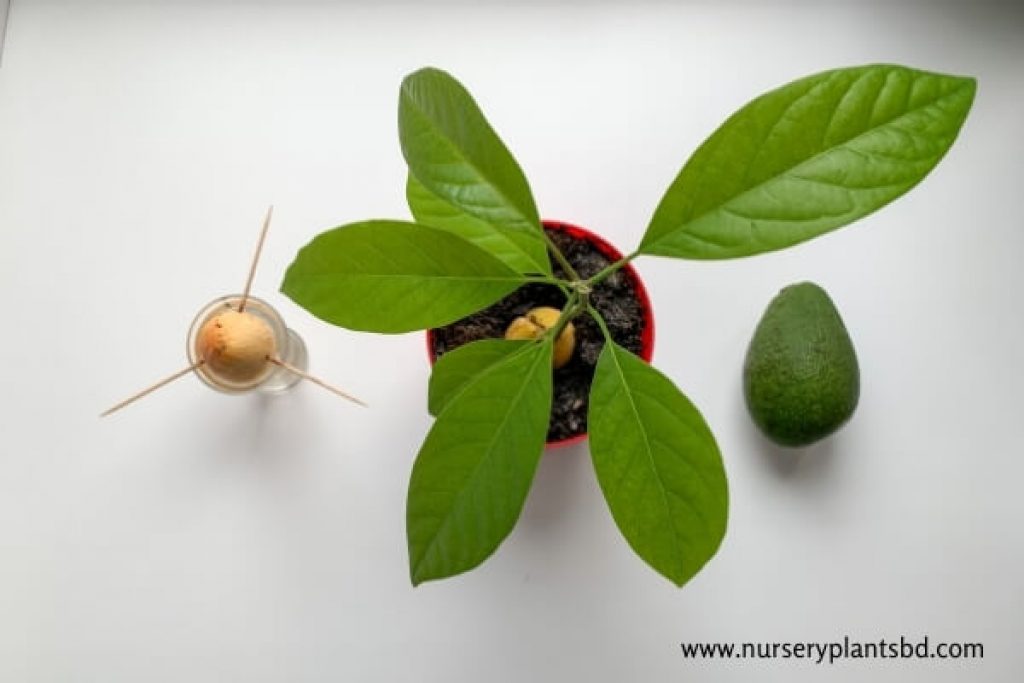
Avocado tree planting is very easy. If you want to know How to Plant an Avocado Seed in Soil, kindly read the articles I hope you will understand the process. If you are facing any issues or have any questions then comment below. We will reply to your comment as soon as possible.
The ideal growing conditions for a potted avocado plant
- should be soil moist and slightly acidic (pH 6-6.5).
- The pot should have good drainage.
- Give them plenty of indirect sunlight. Avoid direct sunlight, especially when young.
- Maintain high humidity and temperature between 65-85 F.
How to Plant Avocado Seed in Soil After it Sprouts Step by Step

- Wash the seeds and remove the brown skin.
The brown outer skin may be firmly attached to the hole. You can gently score the skin level with a paring knife and lift the skin with the tip of my knife. Shallow cuts in the hole will not affect its shoot. In fact, some people may even crack the very top of the open seed to help it sprout. If you do not want to try to peel, you can leave the skin. - Put some soil in a pot and moisten the soil.
Avocado trees grow well in slightly acidic soils (6-6.5 pH) with good drainage. You can use new, rich humus soil or recycle some old soil from your garden or any other pot. If you use old soil, make sure that any weeds, grass, and old roots can reduce the chances of avocado seeds germinating. Add enough water to moisten the soil without flooding. Place the pot in a saucepan to hold any excess water. - Press the soil under the seeds.
Gently press the soil under the seeds so that half of it is still visible. The underside of the seed is usually at a wide edge, although it can be difficult to detect because some seeds are very close to being round. Having the right orientation is important because the roots will grow from the bottom. - Place the pot in a warm place with plenty of sunlight.
Avocados grow in humid and warm conditions (65-85 ° F or 18-30 C). Make sure you get enough indirect sunlight to encourage seed growth. Young trees are sensitive to direct sunlight and extreme temperatures. I put it on top of my kitchen window sill. The south-facing window is the best. - Keep the soil moist while you wait for the seeds to germinate.
It can take anywhere from 2-to 8 weeks to bloom the roots and stems. This is a good sign if you notice that the seed is starting to crack. Check the soil every few days to make sure it stays moist. If you can’t leave your fingerprints when you press on the ground, it needs more water. - Cut the newest leaves at the top to encourage fuller, bushy growth.
For mature plants, cut the new leaves blooming at the top of the stem. It helps in controlling the height of the plants. Do this whenever the tree is six inches bigger. - Consider cutting the stem to at least six inches at a time.
This is a technique that can encourage new growth and help prevent the plant from becoming a long stalk with a few leaves on top. Do not do this until you find a set of leaves under your tree where you want to cut.
Avocado seeds can take a few weeks before the roots and stalks spread.
The Avocado Tree
Avocados are one of Bangladesh’s most popular exotic fruits. This fruit is less effective than other fruits and is very useful for people with diabetes. The size of this fruit is very similar to that of guava or pear. Each fruit weighs 300-600 grams. Inside the fruit are large oval seeds. The edible portion is as smooth as butter, with a slightly sweet taste. For the same reason, it is known to many as the fruit of butter. There are various benefits of eating ripe fruit such as papaya, vegetables, mash, salads, and sherbet. It is healthy to eat avocado cream instead of butter on toast, and avocado cream instead of mayonnaise in salads and sandwiches.
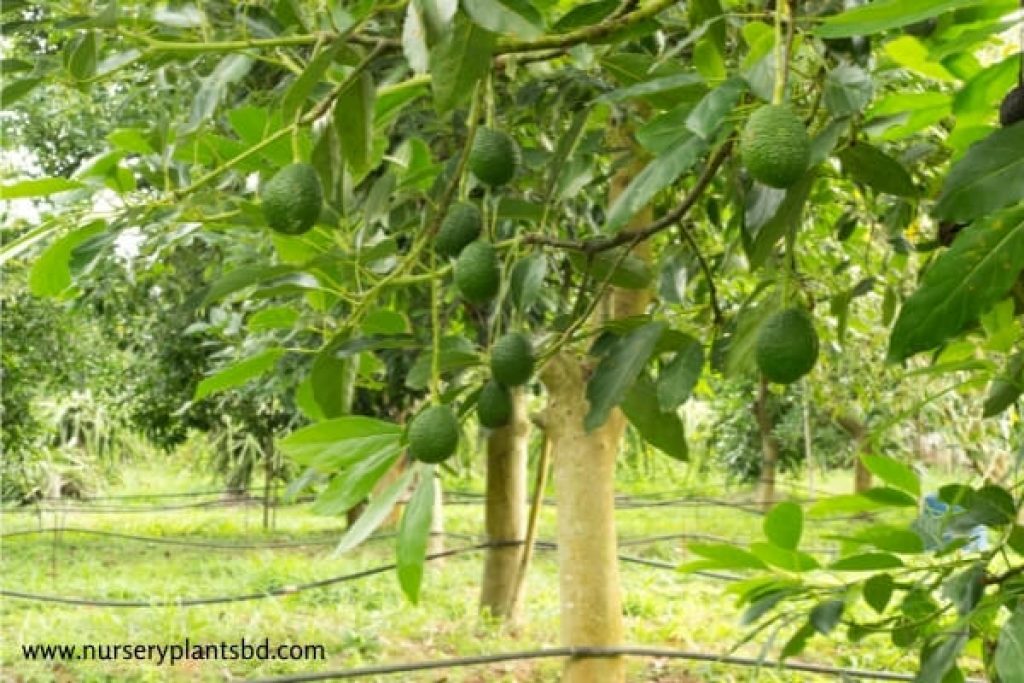
Where Does Avocado Grow?
Mexico and Guatemala are the origins of avocado fruits. It later spread to the United States and the Caribbean. Mexico, Chile, Indonesia, Colombo, Peru, Kenya, Brazil, Rwanda, and China are other countries that produce more avocados. Currently, the cultivation of this fruit is increasing in Sri Lanka, Vietnam, the Philippines, Thailand, Israel, the Netherlands, and India. Currently, 60-70 enthusiastic growers in various parts of Bangladesh are successfully planting this fruit.
However, these trees are made of seeds and the number of avocado trees is very low, not more than two to four. Avocado trees planted in 5 to 6 agricultural areas under DAE have begun to bear fruit. Currently, many fruit lovers are eager to grow an avocado tree.
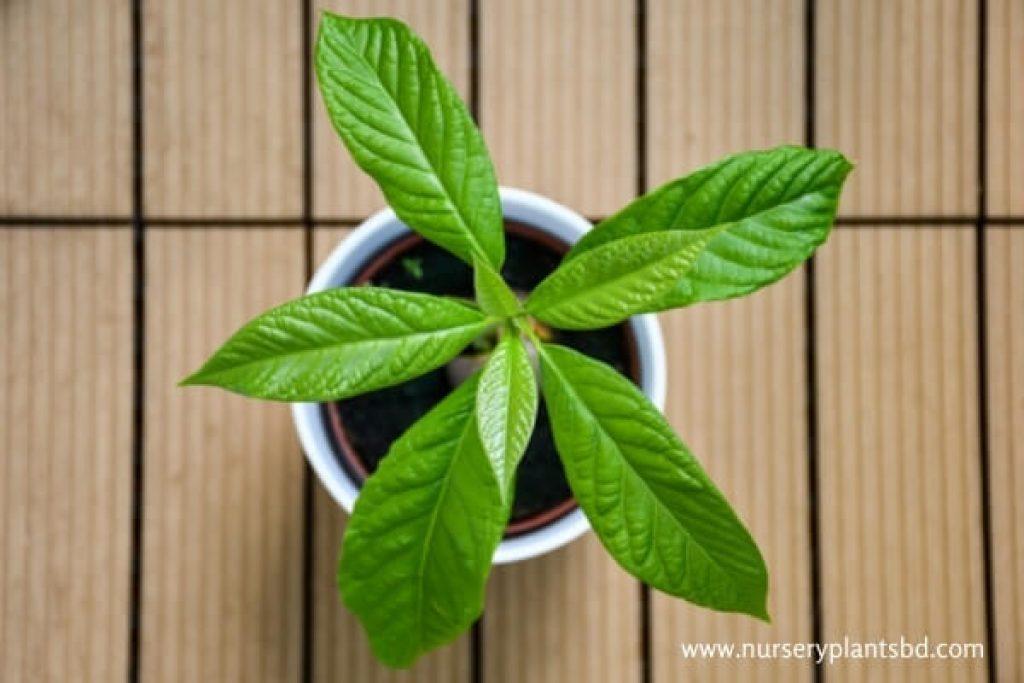
Avocado Nutrition and healing properties
Avocado is a nutritious and healing fruit. The fruits avocado maintain the body free of sodium, sugar, and cholesterol. This fruit is very rich in calories, contains enough fat in the body, keeps the heart-healthy, and helps control cancer and cholesterol. Soluble nutrients (A, D, K, E) are many, that act as a stimulant to keep the body healthy. The importance of eating avocado fruit in the health and growth of children is enormous. This fruit is known as another form of breast milk.
As a result, it contains many important vitamins and minerals. It is rich in phosphorus, magnesium, zinc, copper, and manganese. Vitamin C, and B-6, In addition to riboflavin, are rich in essential fiber. This fruit works to prevent muscle and bone loss in adults and to prevent cancer in various organs of the human body. The avocado diet prevents the expectant mother’s pregnancy and aids in normal delivery. This fruit is essential for maintaining good health by eliminating stress, and anxiety, dieting, ensuring good sleep, and disposing of harmful substances such as urine and feces.
Avocado Tree Planting
After eating avocados, the temptation to plant your own plant is almost irresistible. There are several ways to do this. You may have heard how to use toothpicks on the sides of a hole and then dip the bottom of the hole in the water. However, I have found that this method does not always work, especially for me. When the seeds germinate, you will need to plant them in a soil pot.
There is an easy way to plant an avocado tree without using a toothpick. I have learned this simple method of sowing seeds directly in some soil in a pot after at least one failed attempt by a toothpick. In this way, it also mimics the seeds that grow in nature.
My mother put avocado seeds in the pot of another plant and forgot that she meant to try the method of toothpicks. To his surprise, a few months later he discovered that it had exploded. I tried to start the soil deliberately, and I succeeded. Then I research more and more about avocado tree planting and find out the best process which is presented below.
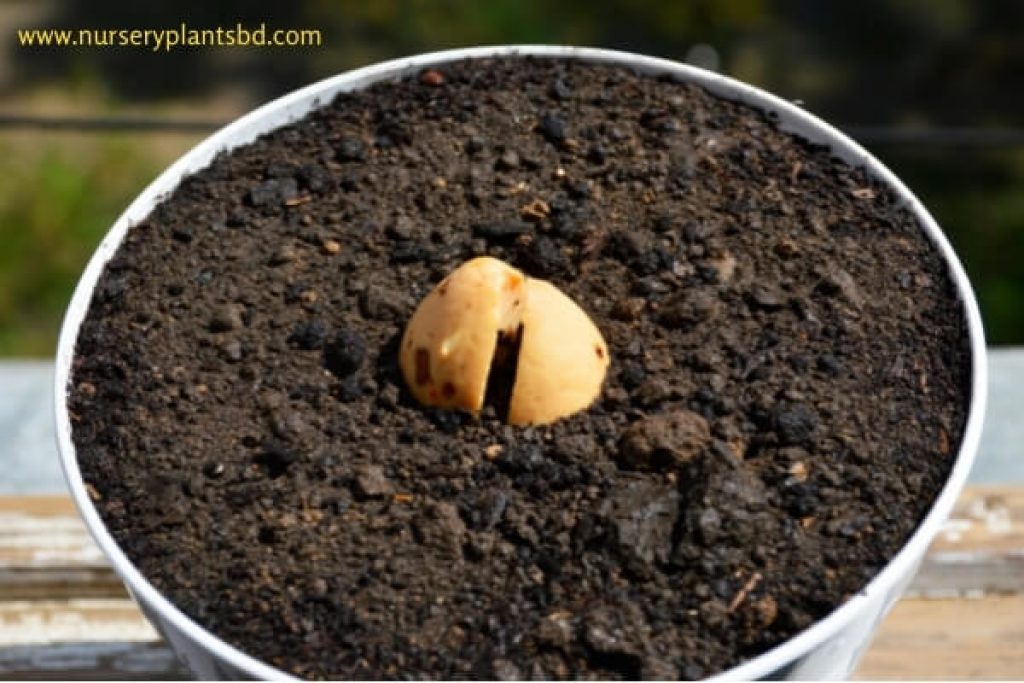
Climate and soil:
This fruit is ideal for tropical and subtropical climates. The rainy, humid, and hot climate of summer is ideal for growing crops. However, the fruit carries high temperatures, dry air, and frost tolerance during flowering. In late winter, February-March, 180-250 cm is best suited for flowering and fruit and 250-350 Celsius for fruit growth. Avocados provide a good harvest at an altitude of 800-1200 meters above sea level. This fruit is likely to be spread over the highlands of the northern regions, including the mountainous regions of the country.
Avocados can be grown in almost all types of soil. Good yields are mainly found in red soils with drainage (Barind and Madhupur average) and clay soils. The salt tolerance of this fruit is less than that. Soil pH level 5-6 is best suited for planting. The tree has no full tolerance for water. Therefore, drainage is made easier, the water level is very low (R3-R4), it gets the sun all day and high soils should be chosen to cultivate this fruit. The soil for growing avocado must be fertile and rich in organic matter.
Varieties:
Hundreds of varieties of avocados are grown in the world. Species are divided into three races or families. These are. Mexico, b. Guatemala and c. West Indian species. Mexican fruits are small in size (250 g), and the skin of the fruit is thin and smooth, resulting in a high-fat content (30%) and frost tolerance. Guatemalan fruit is very large (600 g), the fruit is long, and the skin is thick and uneven. Western Indian fruits have a medium size, (300-400 gm).
The fruit is smooth and light. Western Indian racing avocado is best suited for planting in Bangladesh. Among the best-known varieties of avocado-producing countries are Has, Fuerte, Bacon, Reed, Pulok, Jutano, Jan, Linda, and Nabal. During the transplantation, new varieties are formed from seedlings such as mangoes. However, the quality of the mother plant is not maintained, naturally, the yield and quality of the fruit decrease.
Propagation:
The proliferation of avocados is done by making seedlings from the seed in an asexual way and by cutting through the organ system. All the trees grown in Bangladesh are seedlings. In India too, most avocados are produced from seeds.
Seedling production from seed:
Seedlings are planted in the seedbed to form seedlings from collected fruit. Seeds need to be planted as soon as possible after collection. Because the germination capacity of collected seeds does not last more than 2-3 weeks. Yet, 50 seconds If the seeds are stored at room temperature, germination capacity can increase in a few months. The same amount of soil, before planting the seeds in a seedbed or bathtub It is best to make the media mixed with sand along the coast. If the top cover of the seeds is removed before planting, the seeds will germinate very well. When planting the seeds of this fruit, it should be noted that the majority of the seeds are below.
The upper part of the seed should be covered with a small thick layer (2/16) of reddish-brown sand and cork dust. The soil of the planted seed needs to be cleaned with a fungicide. Care should be taken to ensure that there is no shortage of flour in the soil of the planting bed and to help the seedlings grow with little irrigation with standard springs. The top part of a cup or plastic bottle is cut and the seeds are sown in water but the seedlings grow from the seeds. In this case, it is necessary to take steps to place the seeds in 30% water and 80% water.
If the seedlings grown in this system are 5 to 6 cm tall, they should be planted in bulk bins or bags and allowed to grow. Action must be taken. If the seedlings grown in this system are five to eight inches tall, they should be planted in bulk bins or bags and allowed to grow. Action must be taken. If the seedlings grown in this system are 5 to 6 cm tall, they should be planted in bulk bins or bags and allowed to grow.
By way of Grafting:
Two to three feet high seedlings are ready for transplanting. The Kolom is made mainly using a stripping, veneer, or side mounting method, and the success rate increases. The Kolom can be used all year round. However, it is eligible for connection from February to October. Avocados can also be distributed by way of emergence. The success rate increases with Koloms in races. The Mexican race cannot be linked to the West Indian race, but all species can be combined with Guatemala and hybrid Zion.
Sapling/grafting:
Saplings/grafts are usually planted at a distance of 20-25 feet to create a garden. Planting a yard or two or three rows of trees at a distance of 15 to 18 feet is enough. Avocados are very useful in providing half the shade in the tea garden. However, in this case, it is necessary to provide a distance of 30-400 feet. Large sizes such as Fuart and forest species need to be planted at a high distance (30-35). Avocado gardens need medium distances (orange, guavas, cool) to build a long enough distance (30-35 feet).
Before planting a tree, you need to make a ‘ground plan’ and start identifying designated planting areas and making holes there. The size of each hole is 3 feet long, It should be wide and deep (r3dhr3dhr3). After making a hole, if the sun is raised for 3-4 days or if the grass is left in the hole and burned, the diseases and pests that live in the soil will be under some control. The mixture to be used to fill the hole is by
(A) Rough sand (Sylhet sand) 15%, (b) Grade 3 15% cone marble brick (c) 15% coconut powder, (d) Fertile soil 25%, (e) Rotten manure / Arbajana Rotten 30%
should be mixed with bone powder-1 kg, vermicompost 5 kg, TSP 400 g, MOP-300 g, zinc sulfate, mag sulfate, ferrous sulfate, and boron 100 gm. After combining all this fill the hole and leave it for 15 days, it is advisable to plant trees there. Before planting the seedlings need to be watered for a day or two in a row. In this process, the soil mixed with fertilizer will be best suited for planting trees.
Avocado seedlings can be planted at any time of the year with irrigation and irrigation systems. However, if the trees are planted in April-May before the onset of heavy rains, the roots can spread quickly before the onset of rain and winter, increasing the tree’s ability to grow in adverse conditions. It is best to plant the seedlings/cut in the middle of the mother made by growing it from the ground up. To ensure the benefits of pollination and high yields, the same number of seedlings of trees ‘A’ and ‘B’ should be planted in a ratio of 1: 1 or 2: 1. let us not fall into the storm.
Fertilizer application:
Nitrogen Fertilizer, Phosphorus, and Potash at 1: 1: 1 in the growing phase and 2: 1: 2 in 2: 1: 2 are required to apply the main chemical fertilizer. The amount of fertilizer required to be applied to each tree per year depending on the age of the plant is as follows
The recommended fertilizers for each year should be divided into two parts and one part should be used at least twice a year. Apply 50% of the fertilizer in May-June before the storm and the other 50% in September-October at the end of the storm and wet it thoroughly with water. In addition, it is necessary to apply Magsulfate, Zinc Sulphate, Ferrous oxide, and Boron fertilizers at a rate of 100-200 gm per year depending on the age of the plant. If the soil pH level is low, it can be done even if ferrous sulfate is not given.
Increase in good pollination system:
From February-March, the tree has mango-like fruit and has 200-300 small flowers. Although each small flower is bisexual, it is unlikely to be pollinated by flowers from the same tree. Therefore, more trees should be planted in the garden to pollinate and increase yields. The different varieties of avocados are divided into two types depending on the shape of the female and male flowers. (A) The first type is identified as type ‘A’ (Hash, Second, Guatemala, Easy) (b) The other type is identified as type ‘B’ (Bacon, Fuerte, Jutano, Nabal). Female genital mutilation ‘A’ received pollen at 8-11 a.m. and male pollen at 3-7 pm the next day.
On the other hand, the ‘B’ female organ is ready for pollen at 3-6 pm and the male organ at 8-11 the next morning. For the same reason, having A and B trees in the garden helps to bear fruit by eliminating pollen incompatibility.
Training/Pruning:
A small-scale training program to ensure that up to 4-5 feet of stems are built and helps to leave an equal number of stumps on all four sides. Some species of trees grow at the top and some species spread many trees and stems and touch the ground below. Steps need to be taken to prevent overgrowth and to cut off excess shoots to ensure free airflow and increase fruit yields. However, excessive pruning may reduce yields.
Sprinkler System For Avocado:
Avocado trees do not need much watering. A drainage system is much needed during the rainy season. However, in the dry season, if irrigation is given at 3-4 weeks, the fruit is very productive and the fruit size is large. During the dry season, however, it is best to include mulching around grass, dried water hyacinth, and herbaceous plants at a size of 4-5 inches. In this system, milk is stored in the soil, in weed control, and later this meets the needs of the plant as a source of organic compost rot.
Diseases and pests:
This fruit tree is prone to root rot, leaf rot, and root rot. Trees can be kept safe by keeping the garden clean and tidy so that water does not accumulate during the rainy season. In addition, it is necessary to keep the plant healthy by using fungicides made from copper compounds and other useful fungicides. Invasion by worms, bedbugs, measuring insects, and fruit flies are occasionally seen on avocado trees. If these pests are attacked, steps must be taken to protect the plant from pests by spraying with appropriate pesticides.
Fruit collection:
Nutritious or ripe fruit is mainly available in August-September. The color of the small fruit is very green, but when fed or ready for collection, the color of the fruit changes to a light green or a little gray or brown. In this country, it takes 5-6 months for the fruit to ripen, and in some countries, it takes 8-10 months for the avocado fruit to ripen. Unlike other fruits, the fruit does not ripen and fall off. Nutritious fruit is stored indoors for 5-6 days and the fruit is soft and ready to eat. This fruit has the potential to be stored on a tree for a long time.
Nutritious fruits can be collected from the tree for up to a month and a half. Depending on the age and variety of the tree, 200 to 500 fruits can be found on each tree. Do not hold more than 1-4 fruits in the crowd or in the trunk. Some trees seem to blossom and bear fruit prematurely. Collected fruit can be stored for 1-2 months if stored at a temperature of 5-6 C.
Since avocados are very useful for expansion in Bangladesh. It is important to identify the right varieties of this nutritious fruit and take part in its spread.
Avocado Plant Care
- Store your avocado plant in a warm, sunny place.
- Water often with deep immersion from time to time. Keep the plant moist but not overcooked. Like most plants, make sure that the soil is well-drained.
- Apply the stem back each time your plant grows another six inches or more, to enhance the appearance of the bush.
- If you live in an area with a warm climate, plant your tree unless it is old enough. Overtime (we talk for many years), it may bear fruit.
Avocado Price in Bangladesh
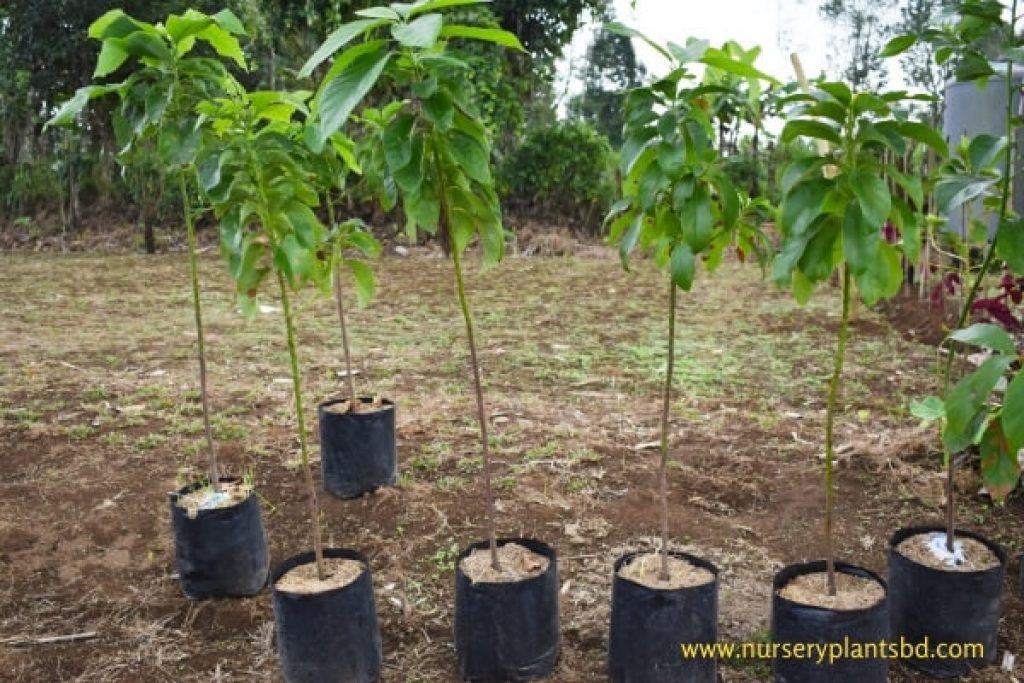
Avocado fruit has a high cost in Bangladesh. 1 kg avocado price in Bangladesh is 1000 BDT to 1500 BDT. You can check out the price from the Cellsii shop.
Nowadays, avocado is planted in our country. You can buy the best avocado fruit trees from Nurseryplantsbd shop. You can also check durian, passion, rambutan, dragon, cat’s eye, brunei king mango, aloo bukhara, lemon, and more.
The Best Avocado Fruit Trees For Sale
Question And Answer About Avocado Tree Planting
There are some common questions about avocado tree planting like
- How to grow avocado trees?
- How to grow an avocado tree that bears fruit?
- How long does it take to grow avocado trees?
- How to grow avocado trees from a pit?
- How to grow an avocado plant?
- Caring for Aloe Vera Plant Best at Home and Outdoor
- Awesome Rose Gardening Ideas
- Best Article For “How To Propagate A Prayer Plant”
We have tried our best to collect the best answer. If you don’t understand or want to know more in detail you can comment below or contact us.
How to grow avocado trees?
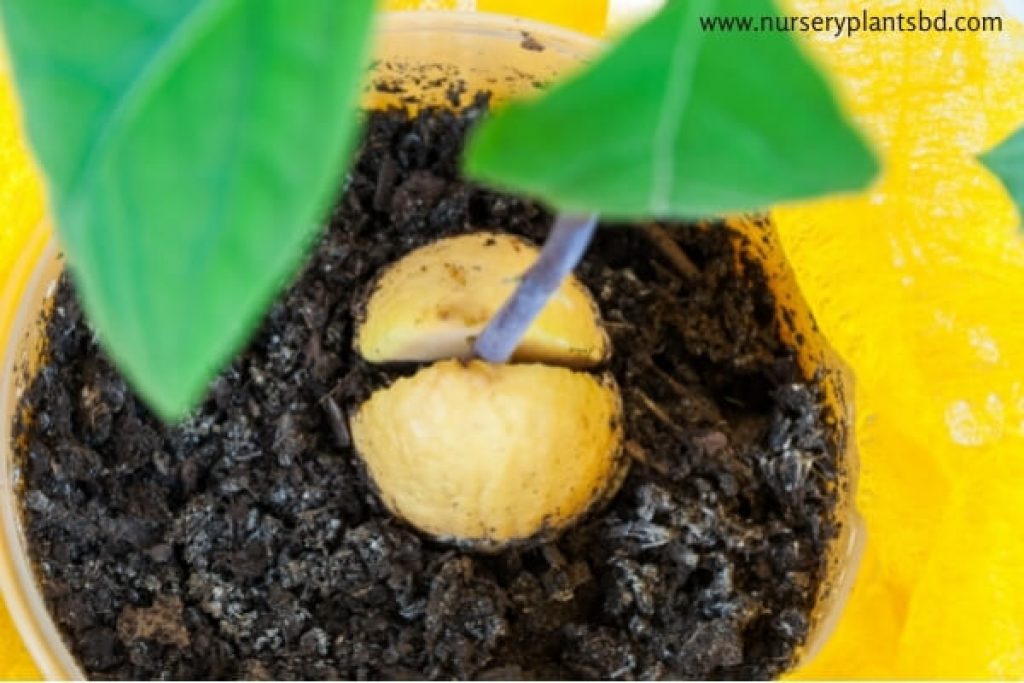
Avocado trees are tropical plants in southern Mexico. If you live in an area where winter temperatures drop regularly below freezing (in the United States, only southern tips for growing avocados outdoors), plant an avocado tree in a container so you should replace it indoors for the winter. Indoor avocado trees should be grown to cover the soil, not the soil, to allow air and water to circulate freely.
If you live in a warm enough area, you can plant outside. Avocados thrive in temperatures between 60 and 85 ° F. Hold a hole slightly wider than the current root ball but as deep as a root ball. Planting too deep or too far above the ground can cause problems.
Try not to interrupt the root system during planting. Water the newly planted avocado tree every 5 to 10 days with plenty of water. It is best to irrigate too deeply to force the roots to grow into the water. Keeping about six inches from the trunk of a tree, a 3-inch fire cover to 6 to 6 coarse bark or cocoa bean pods to keep moisture.
How to grow an avocado tree that bears fruit?
We have already covered the answer to how to seed avocado plants. Please read the avocado tree planting section for it.

How long does it take to grow avocado trees?
Planting an avocado plant (Persea Americana) in the soil is fun and educational, and it usually only takes two to six weeks for the pit to germinate. After that, the plant takes 10 to 15 years to grow large enough to provide fruit, which it does only in the right conditions for growth.

How to plant avocado seed in water?
How to grow avocado trees from a pit?
- When you have finished your avocado, wash and dry the pit.
- Fill the jar with water, almost to the brim. (Or, if you want to have fun, there’s this thing)
- Find the wide end of the pit. This is the end that will point down to the water.
- Press three toothpicks around the pit. These will dry the pit at the edge of the pot. Place the toothpicks so that about one inch of the avocado pit is in the water.
- Place the pot in a warm, sunny place, but without direct sunlight. The sill is really nice.
- Fill with water as needed.
- Your pit should start to grow roots and stems within two to six weeks.
- If you do not see growth in eight weeks, start again with another pit.
- When the stem has reached six to seven inches in height, cut it in half.
- When the roots have grown and the stem has sprouted again, plant in the soil in a pot about 10 inches wide, leaving half of the seed exposed above the soil.
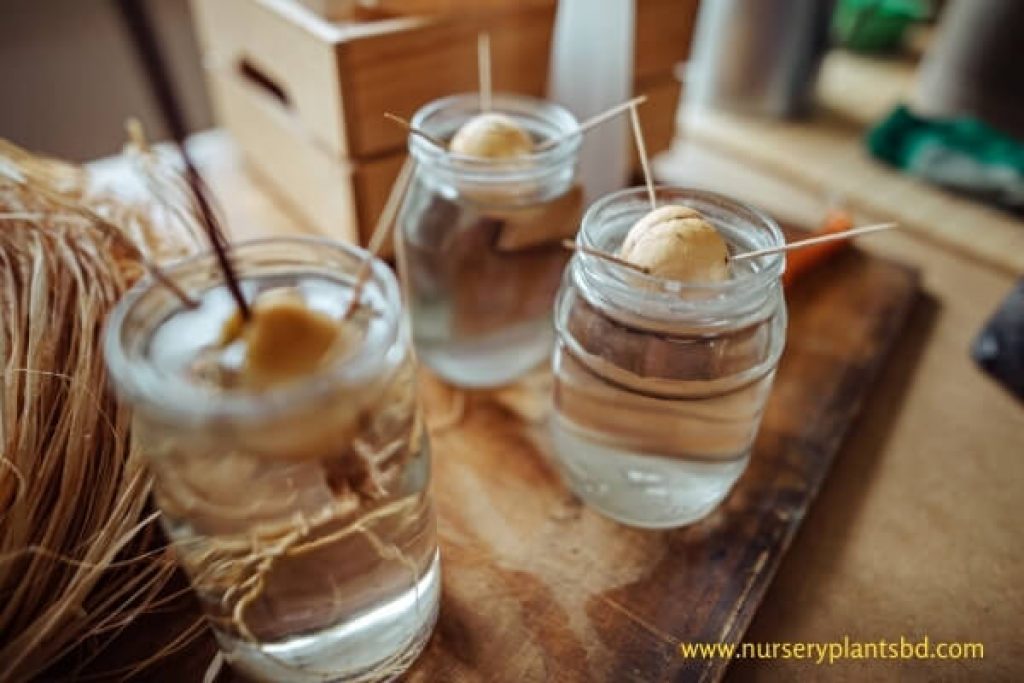
How to grow an avocado plant?
If you read the whole section of this post I can tell that you have got your answer for How to Grow Avocado Plant.
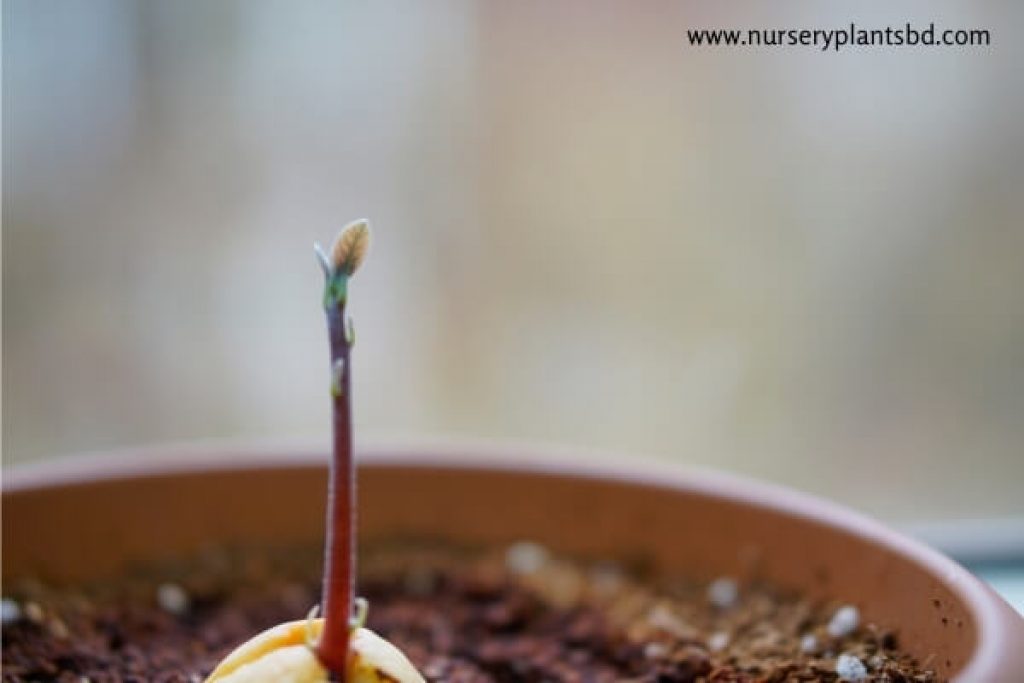
How to grow avocado trees from seed?
No need to explain further how to grow avocado trees from seed. You can take the answer from question number 1 or 4.
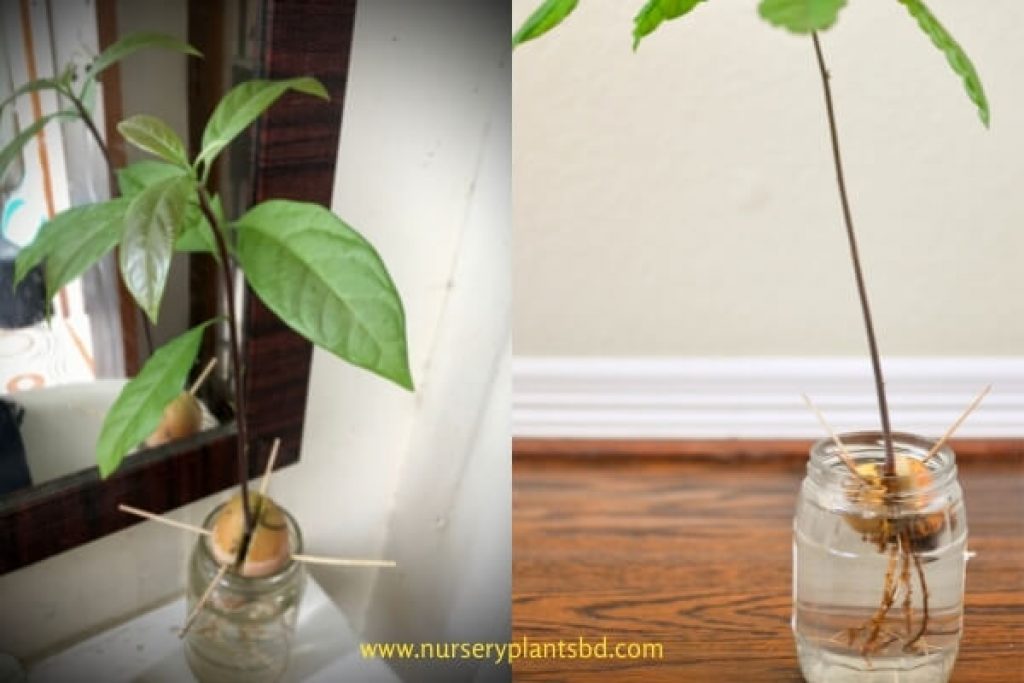
How to Grow Avocado Indoors?
A home-grown avocado can start with a pit but is most effective with a well-filled tree trunk. Planted avocados are planted with a matching stump. A seed-bearing plant is less likely to bear fruit, but it will produce a more attractive tree. Remove the pit from the ripe avocado and wash off any excess meat. Insert the toothbrush network into the pit and place it on top of a glass of warm water. The pit should be immersed in an inch or so of water in a dark or dull end.
Place the glass in bright light at a temperature of at least 65 degrees Fahrenheit (18 C.). Change the water regularly. Soon the pit will produce roots, which will grow into the water. Eventually, the stems and leaves will sprout. When the roots fill a lot of glass, it is time to re-fill the pot.

Avocado planting with container
Growing avocados in the house is fun and easy. Move the sprouted pit into an unregistered terra cotta pot at least 25 cm (25 cm.) Wide and twice as deep as the roots. Use a mixture of baking powder and compost mixed with sand for a loose and quick texture. Growing avocados in containers inside also require bright light. The plant will get solid without adequate light. Sprinkle overgrowth early to promote a strong, sturdy plant. Don’t expect fruit when planting avocados in containers. Indoor plants need a cool night to force flowering and fruiting. It can also take up to ten years to reach the fruiting stage. When you get fruit, the taste is not as good as it is commercially produced from the roots.
Conclusion
In this post, We have tried everything about the avocado tree planting process. If you like this post, you can share it on your timeline. If you think there is anything wrong or missing or wish to add more, you can comment below or contact us. Thank You.
You can also read:
Tags: avocadoavocado price in bangladeshavocado treeavocado tree plantinghow long does it take to grow avocado treeshow to grow avocado planthow to grow avocado treeshow to grow avocado trees from pithow to grow avocado trees from seedhow to grow avocado trees indoorsHow to Plant an Avocado Seed in Soilhow to seed avocado plantwhere does avocado grow













